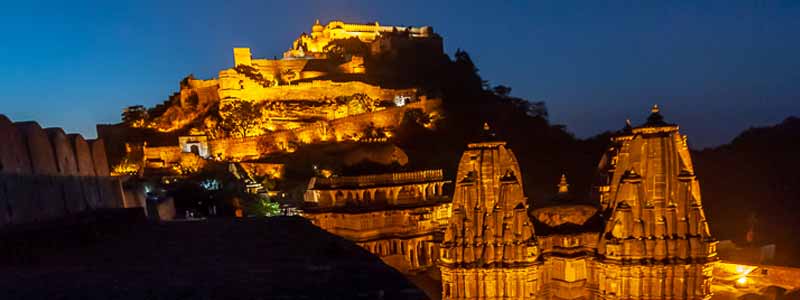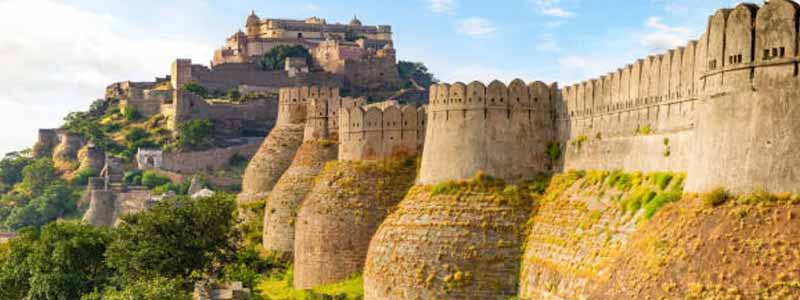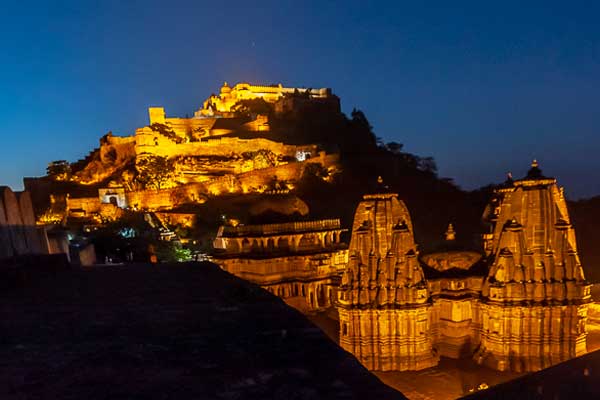Kumbhalgarh Fort is one of the five hill forts of Rajasthan that were declared the UNESCO world heritage site in 2013. Situated in Rajsamand district of Rajasthan, around 82 kilometres from Udaipur, Kumbhalgarh Fort has the second largest wall (38km) after the great wall of China. Constructed on the foothills of Aravalli ranges, it is surrounded by thirteen hill peaks of the ranges and is perched at an elevation of 1,914 m. The magnificent fort is situated in the middle of a forest which has been turned into a wildlife sanctuary. It is the second-largest and the most important Mewar fort of Rajasthan after Chittorgarh palace.
Under the reign of Mewar kings in Rajasthan, the majestic fort was built by Rana Kumbha in the 15th century between AD 1443 and 1458 under the direction of Mandan who was a very renowned architect of that time. The fort was constructed in the exact same place where an old castle existed which was attributed to Samprati who was a Jaina prince of the second century BC. Named after the King Kumbha, the Kumbhalgarh fort was cleverly designed on a hilltop to provide the strategic position to the Mewar kings to protect them against the attacks of the enemy.
The fort is also the birthplace of Maharana Pratap, one of the most powerful kings of Mewar. Also, Badal Mahal was constructed inside the fort by Rana Fateh Singh, who was one of the most famous builders of the time. Badal Mahal, Kumbha Palace, Jain Temples, Baoris, Chhattris, water reservoirs and Brahmanical are some of the main buildings inside the spectacular fort.

Kumbhalgarh Light and Sound Show
Every evening, the fort wakes up to a fascinating display and narration of its history through a light and sound show. The Kumbhalgarh light and sound, held in Hindi, is a key attraction for visitors who want a glimpse into the fort’s past.
- Duration: 45 mins
- Timings: 6:45 pm to 7:30 pm; every day
- Tickets: ₹ 100 for Indians; ₹ 200 for foreigners

Things to See in the Kumbhalgarh Fort Complex
The sprawling fort complex has many well-preserved structures that narrate the saga of its rich past. The things to see in Kumbhalgarh include:
- Kumbha Palace, the residence of the king
- Badal Mahal, a two-storied structure built by Rana Fateh Singh
- Lakhola Tank, constructed by Rana Lakha
- Ram Pol, the main gateway to the fort
- Aaret Pol, Hanuman Pol, and Halla Pol, other major gateways to the fort
- Badshahi Bavdi, a water tank
- Hindu temples, including the ancient Ganesha temple and Neel Kanth Mahadeva temple
- Jain temples, including the Parsva Natha temple, Golera Jain temple, Mamdeo temple, Mataji temple, Surya Mandir, and Pital Shah Jain temple
- Chattris, Baoris, and water reservoirs
History of Kumbhalgarh Fort Udaipur
Set amidst a cluster of 13 mountains of the Aravali range, Kumbhalgarh Fort near Udaipur in Rajasthan was built in the 15th century A.D. by Maharana Kumbha – the ruler of ancient Mewar state between 1433 and 1468 A.D. Built atop a prominent ridge at about 1914 m above sea level, this formidable medieval citadel stands majestically as a mute witness to the past glory of its kings and princes.
The birthplace of Maharana Pratap – the legendary king of Mewar, Kumbhalgarh Tour Packages remained unconquered due mainly to its inaccessibility and hostile topography. However, the fort supposedly has thick walls wide enough to accommodate 8 abreast horses.
The Architecture of Kumbhalgarh Fort
Kumbhalgarh Fort near Udaipur is fortified with 33 km of walls, more than 25 feet thick – in fact, the second longest continuous wall in the world. However, the most interesting feature of Kumbhalgarh Fort is that it houses another fort within its precincts. Named the Kartargarh Fort, this smaller fort comprises a palace built by Maharana Fateh Singh. There are as many as 365 temples and shrines within the Kartargarh Fort.
The most beautiful palace inside Kumbhalgarh Fort near Udaipur is the Badal Mahal (Cloud Palace). This palace was renovated in the 19th century by Maharana Fateh Singh.
- Kumbhalgarh Fort Timings: 9.00 am – 6.00 pm
- Kumbhalgarh Fort Entry Fee: INR 10 for Indians, INR 100 for foreigners
